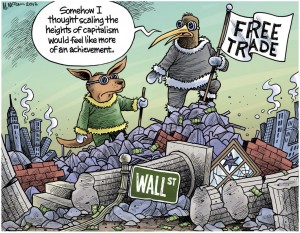TPP paving the rocky road to globalizaton?
A tentative trade pact agreed on Monday and known as the Trans-Pacific Partnership (TPP) would bind 12 nations into the largest economic bloc, covering 40 percent of the world’s economy. It would eliminate 18,000 tariffs. It might boost incomes by 0.5 to 1 percent for the countries involved. For sure, prices on imported products and services would be lower and exports higher.
But the nonnumerical benefits of the TPP, if approved by the US Congress and the other nations’ legislatures, lie in driving the huge Asia-Pacific market – and thus the world – to update and adopt rules of commerce that would be more fitting to 21st-century economies.
Trade rules, like the golden rule, reflect a way for each country to seek a common good. The qualities of trade are as important as its quantities. Values are as critical as value.
This agreement would set modern rules for the free flow of digital information across borders, create better incentives for innovation through the enhanced protection of patents and copyrights, improve working conditions, and curb wildlife trading. Countries with government-run enterprises, such as in Vietnam and Malaysia, would need to show more bureaucratic transparency and less nationalistic favoritism.
Most of all, securing this pact would create an interdependency in a region that needs more cooperation on issues such as climate change and peaceful settlement of territorial disputes. It would also more closely bind the United States to Asia, where American forces have largely kept the peace for decades.
Perhaps these intangibles help explain why the TPP talks took nearly a decade to get this far. Even President Obama was at first wary until he saw an agreement as a way to revitalize the post-World War II international economic order and prevent state-run economies, such as China, from imposing a mercantile approach to trade that would mainly harness free markets for authoritarian rule.
The pact comes as Asia-Pacific leaders are due to meet in November, and perhaps in time for Congress to decide quickly on approving it in an up-or-down vote before the politics of the presidential race get into high gear by next summer.
China, which is not party to the pact but is Asia’s largest economy, can still join it. The pact is structured to easily let in new members. China is already helping set Asia’s agenda, such as a new Beijing-led infrastructure bank. The values in TPP are consistent with those of China’s economic reformers.
But back to the math. This pact could revive the growth of global trade, which has fallen from 6 percent to about 3 percent since 2010. Without new rules of the road to reflect modern values, that number may not pick up. TPP is the Tesla of trade, redefining wholly new ways to speed up the intangible benefits.

